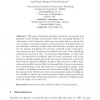Free Online Productivity Tools
i2Speak
i2Symbol
i2OCR
iTex2Img
iWeb2Print
iWeb2Shot
i2Type
iPdf2Split
iPdf2Merge
i2Bopomofo
i2Arabic
i2Style
i2Image
i2PDF
iLatex2Rtf
Sci2ools
ACISP
2007
Springer
2007
Springer
On Proactive Perfectly Secure Message Transmission
This paper studies the interplay of network connectivity and perfectly secure message transmission under the corrupting influence of a Byzantine mobile adversary that may move from player to player but can corrupt no more than t players at any given time. It is known that, in the stationary adversary model where the adversary corrupts the same set of t players throughout the protocol, perfectly secure communication among any pair of players is possible if and only if the underlying synchronous network is (2t + 1)-connected. Surprisingly, we show that (2t + 1)-connectivity is sufficient (and of course, necessary) even in the proactive (mobile) setting where the adversary is allowed to corrupt different sets of t players in different rounds of the protocol. In other words, adversarial mobility has no effect on the possibility of secure communication. Towards this, we use the notion of a Communication Graph, which is useful in modelling scenarios with adversarial mobility. We also show th...
ACISP 2007 | Byzantine Mobile Adversary | Mobile Adversary | Secure Communication | Security Privacy |
| Added | 12 Aug 2010 |
| Updated | 12 Aug 2010 |
| Type | Conference |
| Year | 2007 |
| Where | ACISP |
| Authors | Kannan Srinathan, Prasad Raghavendra, C. Pandu Rangan |
Comments (0)

